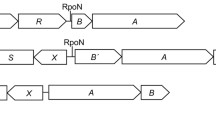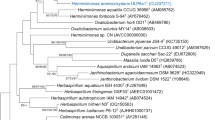Abstract
‘Ferroplasma acidarmanus’ Fer1 is an arsenic-hypertolerant acidophilic archaeon isolated from the Iron Mountain mine, California; a site characterized by heavy metals contamination. The presence of up to 10 g arsenate per litre [As(V); 133 mM] did not significantly reduce growth yields, whereas between 5 and 10 g arsenite per litre [As(III); 67–133 mM] significantly reduced the yield. Previous bioinformatic analysis indicates that ‘F. acidarmanus’ Fer1 has only two predicted genes involved in arsenic resistance and lacks a recognizable gene for an arsenate reductase. Biochemical analysis suggests that ‘F. acidarmanus’ Fer1 does not reduce arsenate indicating that ‘F. acidarmanus’ Fer1 has an alternative resistance mechanism to arsenate other than reduction to arsenite and efflux. Primer extension analysis of the putative ars transcriptional regulator (arsR) and efflux pump (arsB) demonstrated that these genes are co-transcribed, and expressed in response to arsenite, but not arsenate. Two-dimensional polyacrylamide gel electrophoresis analysis of ‘F. acidarmanus’ Fer1 cells exposed to arsenite revealed enhanced expression of proteins associated with protein refolding, including the thermosome Group II HSP60 family chaperonin and HSP70 DnaK type heat shock proteins. This report represents the first molecular and proteomic study of arsenic resistance in an acidophilic archaeon.




Similar content being viewed by others
Abbreviations
- MSM:
-
Mineral salts medium
- RT-PCR:
-
Reverse transcriptase polymerase chain reaction
- 2D-PAGE:
-
Two-dimensional polyacrylamide gel electrophoresis
- MALDI-TOF:
-
Matrix-assisted laser desorption ionization time-of-flight
- ICP-MS:
-
Inductively coupled plasma-mass spectrometry
- HPLC:
-
High pressure liquid chromatography
- TCA:
-
Tricarboxylic acid
- acetyl-CoA:
-
Acetyl-coenzyme A
References
Baker-Austin C (2005) Investigations in the extremely acidophilic archaeon “Ferroplasma acidarmanus”, initial characterisation, application of proteomics and analysis of metal resistance. Department of Biological Sciences, University of East Anglia, Norwich
Baker-Austin C, Dopson M, Wexler M, Sawers G, Bond PL (2005) Molecular insight into extreme copper resistance in the extremophilic archaeon “Ferroplasma acidarmanus” Fer1. Microbiology 151:2637–2646
Busenlehner LS, Pennella MA, Giedroc DP (2003) The SmtB/ArsR family of metalloregulatory transcriptional repressors: structural insights into prokaryotic metal resistance. FEMS Microbiol Rev 27:131–143
Butcher BG, Deane SM, Rawlings DE (2000) The chromosomal arsenic resistance genes of Thiobacillus ferrooxidans have an unusual arrangement and confer increased arsenic and antimony resistance to Escherichia coli. Appl Environ Microbiol 66:1826–1833
Dopson M, Lindström EB (1999) Potential role of Thiobacillus caldus in arsenopyrite bioleaching. Appl Environ Microbiol 65:36–40
Dopson M, Lindström EB, Hallberg KB (2001) Chromosomally encoded arsenical resistance of the moderately thermophilic acidophile Acidithiobacillus caldus. Extremophiles 5:247–255
Dopson M, Baker-Austin C, Koppineedi PR, Bond PL (2003) Growth in sulfidic mineral environments: metal resistance mechanisms in acidophilic micro-organisms. Microbiology 149:1959–1970
Dopson M, Baker-Austin C, Bond PL (2004a) First use of 2-dimensional polyacrylamide gel electrophoresis to determine phylogenetic relationships. J Microbiol Methods 58:297–302
Dopson M, Baker-Austin C, Hind A, Bowman JP, Bond PL (2004b) Characterization of Ferroplasma isolates and Ferroplasma acidarmanus sp. nov., extreme acidophiles from acid mine drainage and industrial bioleaching environments. Appl Environ Microbiol 70:2079–2088
Dopson M, Baker-Austin C, Bond PL (2005) Analysis of differential protein expression during growth states of Ferroplasma strains and insights into electron transport for iron oxidation. Microbiology 151:4127–4137
Dopson M, Baker-Austin C, Bond PL (2006) Towards determining details of anaerobic growth coupled to ferric iron reduction by the acidophilic archaeon ‘Ferroplasma acidarmanus’ Fer1. Extremophiles (in press)
Edwards KJ, Bond PL, Gihring TM, Banfield JF (2000) An archaeal iron-oxidizing extreme acidophile important in acid mine drainage. Science 287:1796–1799
Elvin CM, Hardy CM, Rosenberg H (1987) Molecular studies on the phosphate inorganic transport system of Escherichia coli. In: Torriani GA, Rothman FG, Silver S, Wright A, Yagil E (eds) Phosphate metabolism and cellular regulation in microorganisms. American Society for Microbiology, Washington DC, pp 156–158
Fűtterer O et al (2004) Genome sequence of Picrophilus torridus and its implications for life around pH 0. Proc Natl Acad Sci USA 101:9091–9096
Gihring TM, Bond PL, Peters SC, Banfield JF (2003) Arsenic resistance in the archaeon “Ferroplasma acidarmanus”: new insights into the structure and evolution of the ars genes. Extremophiles 7:123–130
de Groot P, Deane SM, Rawlings DE (2003) A transposon-located arsenic resistance mechanism from a strain of Acidithiobacillus caldus isolated from commercial, arsenopyrite biooxidation tanks. Hydrometallurgy 71:115–123
Hesketh A, et al (2002) The GlnD and GlnK homologues of Streptomyces coelicolor A3(2) are functionally dissimilar to their nitrogen regulatory system counterparts from enteric bacteria. Mol Microbiol 46:319–330
Jackson CR, Dugas SL (2003) Phylogenetic analysis of bacterial and archaeal arsC gene sequences suggests an ancient, common origin for arsenate reductase. BMC Evol Biol 3:1–10
Jones JG, Young DC, DasSarma S (1991) Structure and organization of the gas vesicle gene cluster on the Halobacterium halobium plasmid pNRC100. Gene 102:117–122
Kleerebezem M et al (2003) Complete genome sequence of Lactobacillus plantarum WCFS1. Proc Natl Acad Sci USA 100:1990–1995
van Kranenburg R et al (2005) Functional analysis of three plasmids from Lactobacillus plantarum. Appl Environ Microbiol 71:1223–1230
Lin Y-F, Walmsley AR, Rosen BP (2006) An arsenic metallochaperone for an arsenic detoxification pump. Proc Natl Acad Sci USA 103:15617–15622
Liu J, Rosen BP (1997) Ligand interactions of the arsC arsenate reductase. J Biol Chem 272:21084–21089
Lynne S, Gurr JR, Lai H-T, Jan K-Y (2000) NADH oxidase activation is involved in arsenite-induced oxidative DNA damage in human vascular smooth muscle cells. Circ Res 86:514–519
Masullo M, Raimo G, Dello Russo A, Bocchini A, Bannister JV (1996) Purification and characterisation of NADH oxidase from the archaea Sulfolobus acidocaldarius and Sulfolobus solfataricus. Biotechnol Appl Biochem 23:47–54
Meng Y-L, Liu Z, Rosen BP (2004) As(III) and Sb(III) uptake by GlpF and efflux by ArsB in Escherichia coli. J Biol Chem 279:18334–18341
Mukhopadhyay R, Rosen BP (2002) Arsenate reductases in prokaryotes and eukaryotes. Environ Health Perspect 110:745–748
Noel-Georis I, Vallaeys T, Chauvaux R, Monchy S, Falmagne R, Mergeay M, Wattiez R (2004) Global analysis of the Ralstonia metallidurans proteome: prelude for the large-scale study of heavy metal response. Proteomics 4:151–179
Nordstrom DK, Alpers CN (1999) Negative pH, efflorescent mineralogy, and consequences for environmental restoration at the iron mountain superfund site, California. Proc Natl Acad Sci USA 96:3455–3462
Owolabi JB, Rosen BP (1990) Differential mRNA stability controls relative gene expression within the plasmid-encoded arsenical resistance operon. J Bacteriol 172:2367–2371
Rosen BP (1999) Families of arsenic transporters. Trends Microbiol 7:207–212
Rottenberg H (1979) The measurement of membrane potential and ΔpH in cells, organelles, and vesicles. Methods Enzymol 55:547–569
Saha JC, Dikshit AK, Bandyopadhyay M, Saha KC (1999) A review of arsenic poisoning and its effects on human health. Crit Rev Environ Sci Technol 29:281–313
Sawers G, Bock A (1989) Novel transcriptional control of the pyruvate formate-lyase gene—upstream regulatory sequences and multiple promoters regulate anaerobic expression. J Bacteriol 171:2485–2498
Seaver LC, Imlay JA (2001) Alkyl hydroperoxide reductase is the primary scavenger of endogenous hydrogen peroxide in Escherichia coli. J Bacteriol 183:7173–7181
Surin BP, Cox GB, Rosenberg H (1987) Molecular studies on the phosphate-specific system of Escherichia coli. In: Torriani GA, Rothman FG, Silver S, Wright A, Yagil E (eds) Phosphate metabolism and cellular regulation in microorganisms. American Society for Microbiology, Washington DC, pp 145–149
Suzuki K, Wakao N, Kimura T, Sakka K, Ohmiya K (1998) Expression and regulation of the arsenic resistance operon of Acidiphilium multivorum AIU 301 plasmid pKW301 in Escherichia coli. Appl Environ Microbiol 64:411–418
Tuffin IM, Hector SB, Deane SM, Rawlings DE (2006) Resistance determinants of a highly arsenic-resistant strain of Leptospirillum ferriphilum isolated from a commercial biooxidation tank. Appl Environ Microbiol 72:2247–2253
Vido K, Spector D, Lagniel G, Lopez S, Toledano MB, Labarre J (2001) A proteome analysis of the cadmium response in Saccharomyces cerevisiae. J Biol Chem 276:8469–8474
Wang GJ, Kennedy SP, Fasiludeen S, Rensing C, DasSarma S (2004) Arsenic resistance in Halobacterium sp strain NRC-1 examined by using an improved gene knockout system. J Bacteriol 186:3187–3194
Wang L et al (2006) arsRBOCT arsenic resistance system encoded by linear plasmid pHZ227 in Streptomyces sp. strain FR-008. Appl Environ Microbiol 72:3738–3742
Williams CH (1995) Mechanism and structure of thioredoxin reductase from Escherichia coli. Faseb J 9:1267–1276
Wong MD, Fan B, Rosen BP (2004) Bacterial transport ATPases for monovalent, divalent and trivalent soft metal ions. In: Futai M, Wada Y, Kaplan J (eds) Handbook of ATPases. Wiley, Wienheim, pp 159–176
Wu JH, Rosen BP (1993) Metalloregulated expression of the ars operon. J Biol Chem 268:52–58
Xiang C, Kobayashi Y, Hayakawa T, Hirano S (2004) Arsenic speciation in bile and urine following oral and intravenous exposure to inorganic and organic arsenics in rats. Toxicol Sci 82:478–487
Xu C, Rosen BP (1999) Metalloregulation of soft metal resistance pumps. In: Sarkar B (ed) Metals and genetics. Plenum, New York
Xu C, Shi WP, Rosen BP (1996) The chromosomal arsR gene of Escherichia coli encodes a trans-acting metalloregulatory protein. J Biol Chem 271:2427–2432
Yang H-C, Cheng J, Finan TM, Rosen BP, Bhattacharjee H (2005) Novel pathway for arsenic detoxification in the legume symbiont Sinorhizobium meliloti. J Bacteriol 187:6991–6997
Acknowledgments
We thank Fran Mulholland, Andy Johnston, and Lynda Flegg for technical assistance and suggestions regarding this work. Trypsin digestions and MALDI-TOF MS were performed at the John Innes Proteomics facility, Norwich, UK. C.B.A was funded by a BBSRC studentship. A.S. and B.P.R. were supported by United States Public Health Service Grant GM55425.
Author information
Authors and Affiliations
Corresponding author
Additional information
Communicated by G. Antranikian.
Craig Baker-Austin and Mark Dopson contributed equally to this study.
Electronic supplementary material
Rights and permissions
About this article
Cite this article
Baker-Austin, C., Dopson, M., Wexler, M. et al. Extreme arsenic resistance by the acidophilic archaeon ‘Ferroplasma acidarmanus’ Fer1. Extremophiles 11, 425–434 (2007). https://doi.org/10.1007/s00792-006-0052-z
Received:
Accepted:
Published:
Issue Date:
DOI: https://doi.org/10.1007/s00792-006-0052-z




